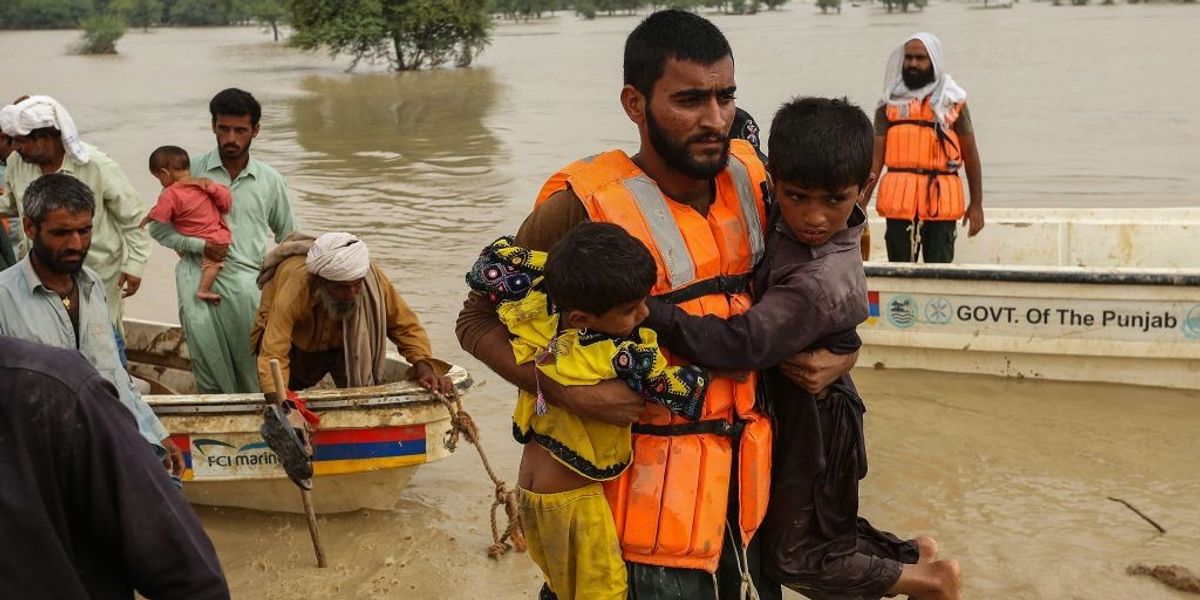
"It is impossible to stay in your home if it is underwater. You cannot grow crops or raise livestock if it has not rained for years." —Atlas of Migration 2022, Rosa Luxemburg Institute
Everybody who is passionate about mountaineering knows about Pakistan, which is home to five of the 14 tallest peaks on the planet. At the same time Pakistan is also a country characterized by sustained population growth and migration outflows. In this short article, we bring the example of Pakistan to elaborate on the issue of climate migration.
Last summer, the extreme monsoon rains, which happened just a couple of months after one of the deadliest heat wave, resulted in the country receiving about three times its usual rainfall for the month of August. Consequently, the Indus river—that starts at the Himalayas and flows through the entire length of the country, before emptying into the Arabian sea—overflowed into its banks and flooded a third of the country, affecting the lives of over 33 million people, and destroying vast stretches of cropland. This resulted in thousands of people losing their lives and the destruction of food crops and other key exports of the country. Six months after the catastrophic floods, the people of Pakistan are still struggling for potable water and sanitation. What makes this all the more poignant is the fact that Pakistan is responsible for less than 1% of the global greenhouse gas emissions that cause these extreme weather events.
However, the people of Pakistan are not alone in this climate vulnerability. According to the Intergovernmental Panel on Climate Change (IPCC), 3.3 - 3.6 billion people across the world live in contexts that render them highly vulnerable to climate change. People living in regions like West-, Central-, and East-Africa, South Asia, Central and South America, Small Island Developing States, and the Arctic are particularly susceptible to climate hazards. The deterioration of environmental conditions due to climate change is forcing more and more people to leave their homes. Experts at the Institute for Peace and Economics estimate that about 1.2 billion people will be displaced globally by 2050 if natural disasters continue to occur at the same rate as the last few decades. But these are conservative estimates, given that such natural disasters are expected to intensify and become more widespread in the coming years.
Contrary to the concerns of many in the West, the Global Trends 2021 Report of the UNHCR—the UN Refugee Agency—shows that almost 60% of the 89.3 million people forcibly displaced migrated to places within their country. Of those that left the country, 72% were hosted in countries neighboring their country of origin. However, international law today only recognizes refugees as those who are unable or unwilling to return to their country due to well-founded fear of being persecuted on grounds such as race, religion, or political opinion. Therefore, the UNHCR prefers to refer to those fleeing their country due to the effects of climate change as 'persons displaced in the context of disasters and climate change,' thereby keeping them out of the ambit of protection granted to 'refugees' under international law.
Efforts towards predicting climate change-induced migration have been difficult because migration is typically driven by a multitude of factors and almost never by a single cause. Environmental factors are increasingly influencing other drivers of migration such as economic (job opportunities), social (education, family), and political (persecution, conflict, policy incentives). A recent report by Oxfam shows the links between climate change and hunger in 10 of the world's greatest climate hotspots. In regions where people's livelihoods depend on farming and livestock, extreme weather events (like floods and droughts), as well as slow-onset events (rise in sea level or desertification) are affecting food security and driving up food prices.
At the face of it, migration presents benefits for the individuals, the sending state, and the host country. At the origin, out-migration can help communities find new income sources and become more resilient to environmental change. At the destination or arrival point, immigration can provide cheap and/or skilled labor force in economies facing the consequences of an aging population and low birth rates. Nevertheless, even in such abject scenarios, the decision to migrate is not as straightforward. The cost of migrating deters the poor (and often, the most vulnerable) from relocating. Even factors such as ongoing conflicts prevent people from leaving these regions. Those who manage to migrate are faced with xenophobic reactions in host countries by people who perceive them as competition for jobs or as a security threat. Studies have found that the effectiveness of migration is impeded by factors such as exploitation faced by migrant workers, the adverse effect on their health, and the increased gender-related vulnerability of women and children where men migrate for jobs.
All this points to the crucial need for international policymakers to address efforts towards climate change mitigation, even as they work to address the reality of climate migration. The latter requires efforts to define, quantify and predict climate migration in the coming years. A potential solution to the former lies in adopting nature-based solutions which are actions that protect, sustainably manage, and restore natural and modified ecosystems to address societal challenges. The traditional knowledge of indigenous communities could prove invaluable in this regard.
For its part, Pakistan has already initiated efforts towards mitigating flood risks by focussing on reforestation and afforestation, wetland restoration, sustainable land management, and green infrastructures. For the rest of us, it is not too late to reduce our carbon emissions and provide the most vulnerable communities with the (financial) means for enabling effective, and possibly nature-based, adaptation.
This post was originally published on Common Dreams.

